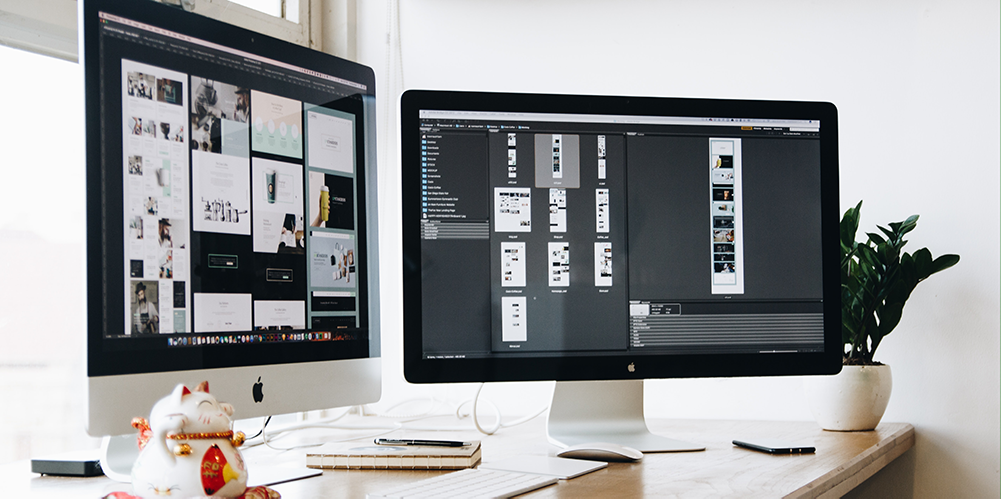Having a well-designed website that reflects your brand is the ideal starting point for tapping into the online community. With the right marketing and content strategies, it will give you a significant advantage over competitors.
But, if you're new to this, it can feel like a daunting process. What type of website will you need? What functionality should the website have? And most importantly; what's the average price for website design?
There are different approaches to website design. As such, the average price to build a website will vary depending on the method you choose and your needs. For example, you might choose to launch your website in phases over time, learning and adapting to visitor behaviours across your site as you go - this is known as Growth Driven Design, or GDD.
In this post, we’ll provide you with the most-important factors to take into consideration that determine the average price to build a website in the UK.
Choosing a developer
Once you decide to proceed with a new website design, it's essential to determine the type of developer you will use. This is the first element that influences costs.
Some of the options available to you include:
1. DIY using a free template
This is one of the best methods for saving money on website development. But it will require you to have some basic technical knowledge. It’s also important to remember that there are many free website design templates out there that aren't necessarily suitable for business websites, so make sure to use one that accommodates all of your businesses needs.
2. Using an agency
Hiring an agency or consultancy firm will necessitate higher costs than doing it yourself. However, they have the advantage of experience and a wider skillset, and can work collaboratively with you to help create a website that does the best possible job of marketing your business.
3. Work with a freelancer
If your vision is too complex for a free template design but isn't complicated enough to justify a consultancy, you can hire a freelancer. This option is more affordable as it allows you to work with an individual designer who wouldn't be as expensive as an agency.
Types of website
There are different types of websites offering varying functionality. Depending on the type you need, the average price for website design may go up or down.
1. Simple, portfolio/catalogue website
A portfolio or catalogue website showcases a person's or company's professional information and work samples.
Having a simple portfolio or catalogue website is cheaper than having an e-commerce site, blog or more complex website. This is because the development work required to create a website like this is limited, and page designs can often be repeated.
2. Small e-commerce website
The average e-commerce website has more functionality than a portfolio or catalogue site. For example, for the average price of website design for an e-commerce website, you can get one that has:
- Online shopping capabilities
- Payment and shipping options
- Product listing
- Displaying and adding product reviews
- Downloadable content
The most commonly known e-commerce sites include Shopify or WordPress with a WooCommerce Plugin.
3. Enterprise e-commerce website
If you want an e-commerce platform with greater functionality, the average price of website design will go up. Apart from the features available in a simple e-commerce website, it has to be more robust and scalable. For example, it should have:
- A custom backend for filtering data, viewing analytics reports and managing orders.
- Customer management that includes integrating with CRMs like Salesforce or Quickbooks for automating customer information updating and follow-up.
- Payment integration like Authorize.net, PayPal or Stripe.
- Shipping plugins or shipping calculators to help determine shipping costs and tax.
4. Multi-language website
Creating a website that is user-friendly in more than one language will be an additional cost, but it shouldn’t be huge if set up from the offset, so make sure to outline this requirement in your initial plans.
5. Bespoke website, requiring complex custom integrations
You pay for what you get, and this is true if you hire a developer to create an app or complex web game that requires customised integrations. You may need to do this to increase security or meet encryption requirements.
This cost can vary depending on the amount of time required to design the website, how functional it should be, the complexity of the integration etc.
Website design requirements
Other factors that influence the average price for a website are the design requirements. These include:
- Branding or rebranding - This goes with a re-design, and its cost will be higher than when you don't have a website.
- Design (front end and UI)- The average price for a front-end website design is less than that of a full-service web design.
- Content strategy - If you want to follow up a website design with a content strategy, you could incur higher average monthly website maintenance fees.
- Template/theme development - If your website can be built using a template, the cost of website design is lower. The same is true if you get an off-the-shelf theme for your WordPress site. Paid themes tend to be more complex and customised than free ones (which has a bearing on average price).
- Custom site design layouts vs. default themes/templates - In terms of cost, the former is higher than the latter. However, custom sites have more functionality and design aspects that need to be accounted for, in terms of their development and eventual management.
Website function requirements
How much functionality do you want or need? Some of the things that will influence cost in this regard include:
Size and scale of the website
Some of the key elements for this are the number and type of pages you want. For example, having pages with products/services pricing and specifications versus just a product catalogue increases costs.
Feature requirements
Some of the features that may influence the price of website design include:
1. Back end and tech stack
Different technologies have different costs. For example, WordPress will cost less than custom app development.
The back end is essentially the workflow and management system in your website. It will determine how you can edit, add or delete content or products from your site. Some of these workflows are advanced and could require ongoing monthly maintenance fees.
For example, if you want a more robust set of plugins for shipping or credit card payments, the cost will increase.
2. Free plugins vs. premium plugins
Premium plugins are usually more complex and tailored to specific business needs. The cost of premium plugins tends to be higher than for website design but allows you to access additional features, priority support, documentation and regular updates.
3. Custom API/integrations
If you want a third-party integration, such as connecting your website to your CRM, the cost will be higher. You could incur setup costs for this and ongoing maintenance fees, but it means you can get your website to work exactly as you want it to, benefitting from better data analysis, reporting and customer experience.
4. Interactive features and functionality
This includes things like video or audio insertion, live chat support on your website and other features that will require custom development. The average price for customisation is higher than more standard functions, but these features aim to deliver a more engaging, persuasive and user-friendly UX.
5. Video embeds and storage
The average price for website design is also higher if you want to embed video and have the videos stored remotely. This is because of bandwidth and other storage requirements, but it does mean your content is more safe and secure.
6. E-commerce: payment models and shipping options
Some businesses need to use more-advanced payment models. While these are designed for the company, they do come with a price tag.
Shipping options can also be complex and require customised development work, raising average website design costs.
However, a bespoke service such as this is often worth the money, since the customer payment experience is vital to the success of so many websites: if a visitor can't have a positive buyer journey with you, then they'll simply take their business elsewhere.
Fees
While designing and during maintenance, there are several fees you need to consider to ensure your website is operational. It's best to know about these up-front, so you can manage your budget expectations.
Upfront costs to consider
- Hosting fees (shared, VPS, dedicated, cloud) - these typically come with domain name pricing.
- Domain registration fees - This is usually for one year in advance and can be paid annually or in 2-4 instalments.
- SSL certificate - If you want SSL security for your site, this will be more expensive than non-SSL.
- Image/video licensing - You may want to use third-party images and videos, which can be more costly but give you greater variety.
Recurring fees to consider
- SEO/content marketing - improving SEO and content marketing will always require some costs on an ongoing basis. This includes hiring a copywriter for your blog, paying monthly fees to social media platforms and Google AdWords if you want to use paid search and social advertising.
- Social media marketing - If you want to be active on social media, this can be costly in terms of time and money. This is especially true for Facebook as it requires a lot of ongoing management from your end (or the agency you engage to do it for you).
- Development retainers - Some businesses will choose to pay monthly or annual fees for ongoing development work. This is usually cheaper than other models but can still be a recurring cost to consider from the start of your website design. Having a team on hand to help with any bugs or challenges that arise can be a very worthwhile use of your budget.
- Growth driven design (GDD) - If you want to drive a lot of traffic to your site, this will mean developing new features and customisations as you go, rather than just at the start of your project.
Additional service costs
Other than the ordinary costs of web design, you may also incur additional costs in the form of design revisions. This will happen when you choose to change direction midway through design work or have to go back to the drawing board.
Having this flexibility is important during website design, but the cost of revisions isn't fixed; it usually depends on your budget or expectations.
Here's a breakdown of website design costs in the UK using a developer:
| Type of website | Cost |
| Simple portfolio website | £1,500 – £2,000 |
| Small business website | £4,000 – £5,000 |
| Interactive website | £6,000 – £8,000 |
| Ecommerce site | £6,000 – £10,000 |
| Custom web application | £15,000 – £100,000 |
| Enterprise level website | £10,000 – £100,000 |
Get in touch with SpotDev to discuss your specific website requirements to see how a digital consultancy can help.
Stay Updated with Our Latest Insights
Get expert HubSpot tips and integration strategies delivered to your inbox.




